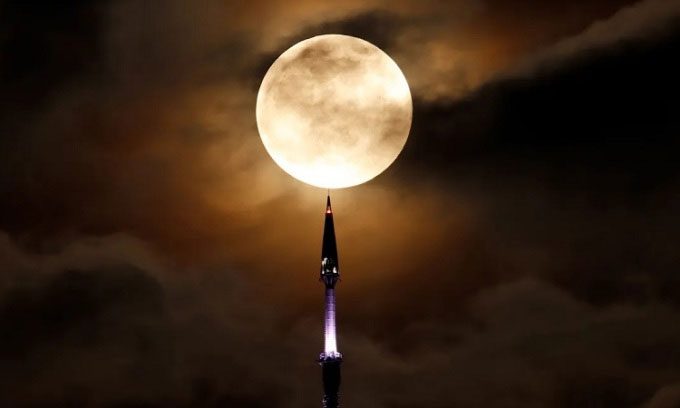The full moon on August 30 will be the closest to Earth, creating the brightest supermoon of 2023.
The largest and brightest supermoon of 2023 will rise on August 30 and is nicknamed the “blue moon.” This phenomenon results from three lunar events occurring simultaneously. The term “blue moon” does not refer to the color of the moon but rather to the fact that it is the second full moon of August, according to Live Science. This is the second time a supermoon appears in the same month (the night of August 1 into the morning of August 2 and the morning of August 31).

Full moon coinciding with supermoon rising in New York. (Photo: Gary Hershorn).
There are two types of blue moons. The August super blue moon belongs to the first category, marking two full moons occurring in the same month, resulting from the moon’s 29.5-day cycle. Besides the sturgeon moon that occurred on August 1, 2023, the full moon on August 30 is called the calendar blue moon, which only appears every 2 to 3 years. The next occurrence will be on May 31, 2026.
The second type is known as the seasonal blue moon, which is the third full moon out of four full moons in a single astronomical season. This occurs when a calendar year has 13 full moons instead of the usual 12. The next seasonal blue moon will appear on August 19, 2024.
A supermoon occurs when the full moon is at its closest point to Earth in its orbit. The moon’s orbit around Earth is elliptical; therefore, each month it passes through the perigee (the closest point to Earth) and apogee (the farthest point from Earth), according to Fred Espenak, an astronomer working for NASA.
The second full moon in August is the third and closest supermoon out of four supermoons in 2023. At a distance of 357,344 km from Earth, this is the largest and brightest supermoon of the year, although it is only about 33 km closer than the supermoon on August 1 (357,311 km). The next supermoon, called the harvest moon, will occur on September 29 and is the last supermoon of 2023.
In Vietnam, the second supermoon of the month will appear on the exact date of the Full Moon (the 15th day of the lunar month). At that time, the full moon will be slightly larger and brighter than usual by about 15%. Observing this event is just like observing a regular full moon, meaning that it only requires clear skies to see the moon. Observers do not need to prepare any eye protection when viewing it.


















































